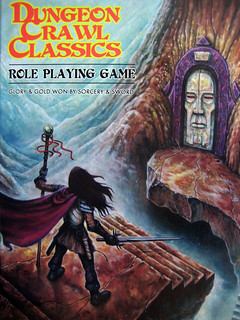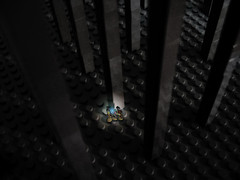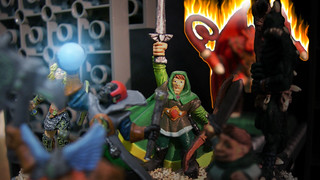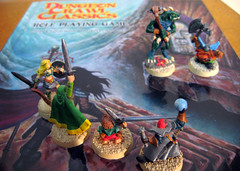

| Archive Blog Cast Forum RSS Books! Poll Results About Search Fan Art Podcast More Stuff Random |
|
Classic comic reruns every day
|
1 {photo of the Fantasy cast}
1 Caption: Old School Roleplaying
|
First (1) | Previous (3234) | Next (3236) || Latest Rerun (2891) |
Latest New (5380) First 5 | Previous 5 | Next 5 | Latest 5 Annotations theme: First | Previous | Next | Latest || First 5 | Previous 5 | Next 5 | Latest 5 This strip's permanent URL: http://www.irregularwebcomic.net/3235.html
Annotations off: turn on
Annotations on: turn off
|
 Dungeon Crawl Classics RPG. |
I am reading a roleplaying game rule book. The game is called Dungeon Crawl Classics RPG. It was published earlier this year. The book outlines a mystical, magical world, in which brave knights team up with arcane wizards, priests of strange and capricious gods, with sneaky thieves, elves, dwarves, and halflings, to explore ancient dungeons, slay monsters, and collect treasure. Despite being published this year, the book doesn't read like a modern roleplaying game book. It's one of a growing set of roleplaying publications that rejects the story and characterisation heavy maturation of the fantasy roleplaying hobby throughout the 1980s and '90s, and the combat-machine optimisations of the 2010s, replacing them with the wide-eyed simplicity of the 1970s.
To paraphrase the main selling point of the book, it proudly proclaims that this is a game in which players don't need to worry about interacting with pesky NPCs[1] who aren't meant to be killed, in which adventure means going into a dungeon and slaying the monsters within, in which it's all about collecting loot. This is the very thing that has often been criticised as overly clichéd and limited in scope, and which has driven the modern evolution of roleplaying games in other directions. So why return to these benighted times?
One answer is nostalgia. People who were kids or teenagers in the 1970s are now adults with disposable income. Many have drifted away from roleplaying and may now be looking back on it fondly. But these newfangled game systems have rules that frankly seem as arcane and opaque to them as the games of the '70s seemed to their parents. Where can I just get a copy of the Advanced Dungeons & Dragons Players Handbook?[2][3][4] The rules I know and love? The gaming aesthetic I know and love? The old style black and white artwork I know and love?
 Dungeon crawling. |
Dungeon Crawl Classics RPG addresses both of these issues. The rules are comfortably familiar, with just enough evolution borrowed from modern game systems to remove clunkiness and make game play more streamlined, and no more. The supported premise of the game is exploring dungeons, killing monsters, and winning treasure. The artwork in the book is old style black and white; it's brand new artwork in many cases by the same artists who illustrated the Dungeons & Dragons books of thirty years ago! Jeff Easley, Jim Holloway, Jim Roslof, Erol Otus! How good is that?! And the rules and game scenarios are simple and fast enough to play that a responsible adult with a job and a family can squeeze in a game with friends without having to dedicate seven hours every Friday night plus prep time on weekends. Basically, it's nostalgic fun wrapped up in a win-win-win package.
Dungeons & Dragons introduced the concept of Armour Class (AC) to roleplaying games. This is a statistic that measures how easy it is for someone to hit you in combat. The other important thing about gauging success at this activity is the skill of the attacker, which is quantified by the level of the character, a statistic that tracks adventuring experience. In the first iterations of the game rules, these two numbers were cross-referenced on a large table to give a third value, known as the to-hit score. To hit in combat, you needed to roll this number or greater on a twenty-sided die. The problem was the cross-referencing and the necessity to have a printed table so you could do this task. The numbers bore a mathematical relationship to one another, but it was a complicated one involving subtractions, division, and some more or less arbitrary rounding off at certain stages, so the table was easier to use. (Also, the mathematical relationship was never explicitly given in the rules.)
 The goal of dungeon crawling. |
It didn't take too long for people to notice that the subtraction could be turned into something more familiar if only the armour classes increased as creatures gained more armour, which was actually more intuitive anyway. The biggest obstacle was tradition - armour classes had always decreased with better armour. For no particularly good reason, but it was now established and going the other way would feel weird to experienced gamers. But if the armour class increases with better armour, then you can map it so that for a particular character the opponent's armour class is their to-hit number! The more armour the opponent has, the higher the number, the harder to hit them. Simple. And to take into account increased adventuring experience, characters of higher levels simply get a bonus on their die roll, and they can record this bonus number on their character sheet. (Effectively, if you want to calculate the number you need to roll on the die, you subtract your to-hit bonus from the victim's armour class. But this sort of taking into account bonuses on die rolls is so common in games that the mental arithmetic involved here seems trivial, compared to flipping mental gears and subtracting an opponent's armour class from a THAC0 score. Most people find mentally accounting for additive dice bonuses easier to handle than THAC0 subtraction, so change won out in the end.)
 The inevitable result of dungeon crawling. |
The appeal of this nostalgic style of gaming is so broad that it has spawned a movement within the gaming community, called Old School Roleplaying (OSR). It has a website. OSR is a mixture of:
 A new way to live old adventures. |
I don't have anything particularly deep or inspired to say about all of this. It was just something I found that brought me so much delight that I had to share it. Maybe some of you reading this have looked back fondly on past years of roleplaying and wistfully reflected that those days are gone because of the difficulty of finding the time to "get back into" gaming. Maybe a few of you will look into the OSR movement and try one or two of the games.
That's reward enough and reason enough for me to dedicate today to this topic.
[2] Not "first edition". It's just the Players Handbook, in the same way that it was The Great War before World War II came along. And the same way it's just Star Trek, not "The Original Series", damnit! Get off my lawn!
[3] And yeah, eBay. That was a rhetorical question, you're not supposed to answer it.
[4] Actually, as it turns out, Wizards of the Coast (who acquired TSR in 1997) are publishing faithful reprints of the three core 1st edition Advanced Dungeons & Dragons rulebooks, less than two weeks after this annotation was published. I did not know this at the time I wrote it! (I added this footnote afterwards.)
|
LEGO® is a registered trademark of the LEGO Group of companies,
which does not sponsor, authorise, or endorse this site. This material is presented in accordance with the LEGO® Fair Play Guidelines. |